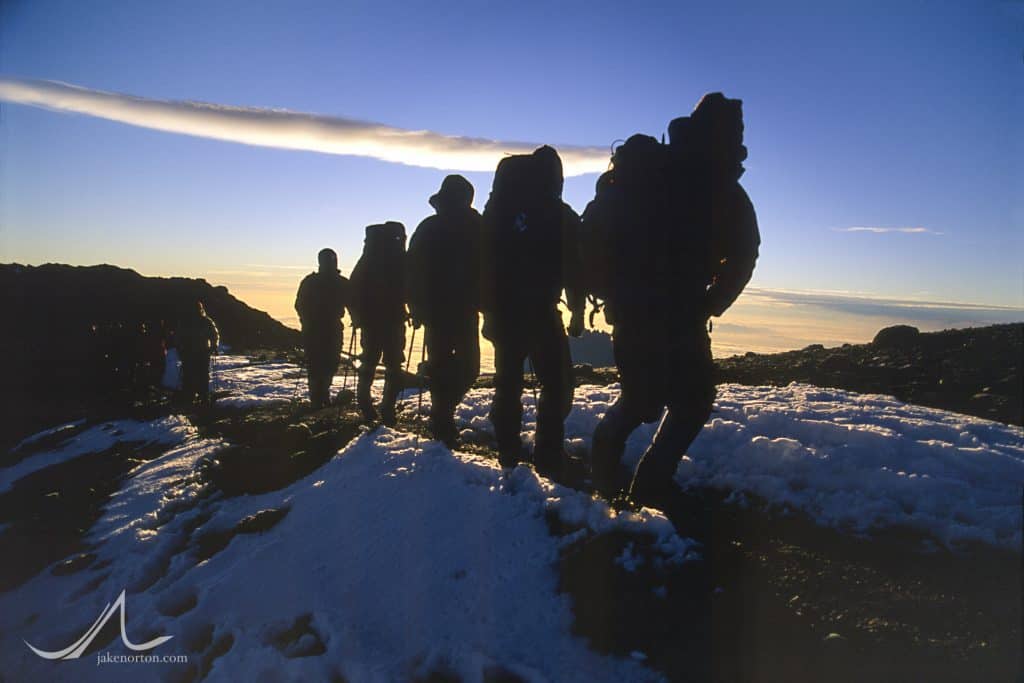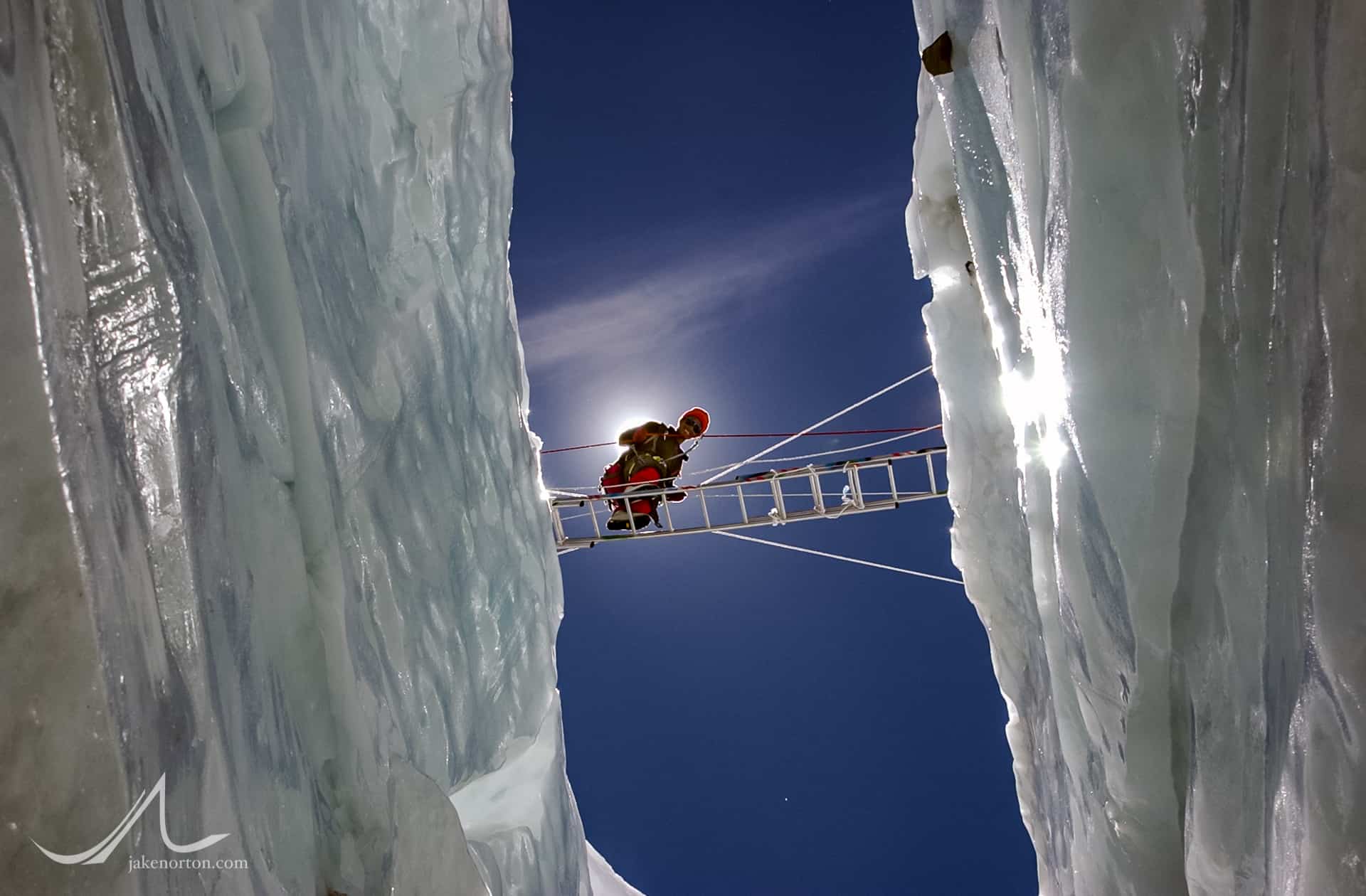This spring on the slopes of Mount Everest a timely (and, in my opinion, long overdue) documentary will be created: Super Sherpas. Focusing primarily on two amazing Sherpa climbers, Apa and Lhakpa Gelu, the film will document their ascent of Everest via the traditional Southeast Ridge Route.
For Apa Sherpa (pictured below in 2002 at Khumbu Basecamp), he will attempt to summit for a record seventeenth (yes, 17th!) time, breaking his own record set last year of 16 summits of Everest.

Lhakpa Gelu Sherpa set a world record on May 25, 2003, by reaching the summit from Basecamp in an astonishing 10 hours 56 minutes – that’s a climbing speed of roughly 1,000 vertical feet per hour!
Together, Apa and Lhakpa Gelu will help show the world the true backbone of Himalayan climbing: the Nepali Sherpa and other Nepali tribesmen (see my article here on the The Sherpas (and sherpas) of Nepali Climbing).
It is sad, but not surprising, how little attention and recognition the Nepali people get for their contributions to Himalayan climbing. From the very first attempt on Everest in 1921, Sherpa climbers were chosen in Darjeeling, India, to accompany the 1921 Reconnaissance Expedition and assist with climbing and load carrying. The following year, 1922, seven Sherpa were killed when a massive avalanche swept them off the North Col Headwall. George Mallory, who was with the 7 Sherpa on the headwall and barely avoided dying himself, wrote to his wife Ruth of the tragedy:
The consequences of my mistake are so terrible; it seems almost impossible to believe that it has happened forever and that I can do nothing to make it good. There is no obligation I have so much wanted to honor as that of taking care of these men.
And, of course, it was Sherpa Tenzing Norgay who, in 1953, forged the way up the final steps of the Southeast Ridge Route with young Edmund Hillary and, on May 30, 1953, the two became the first people to reach the 29,035 foot summit of Everest. Edmund Hillary would later be knighted for his accomplishment; Tenzin Norgay never received such accolades. (Through his efforts and love for the Sherpa people, however, Sir Edmund Hillary has given back in strides to Tenzin’s countrymen through The Himalayan Trust and other initiatives.)
These days, little has changed for the Sherpa and other Nepali people who climb in the high mountains. They still do the lion’s share of the work – setting fixed lines, carrying tents, food, oxygen, and equipment into The Death Zone and the Khumbu Icefall – and sadly get the mouse’s share of the credit for it.

For many of us, names like Edmund Hillary, Jim Whittaker, Ed Viesturs, Reinhold Messner, John Krakauer and more are common and known. But Apa Sherpa, Lhakpa Gelu, and my close friends like Man Bahadur Tamang, Danuru Sherpa, Panuru Sherpa, Karma Rita Sherpa, and others are basically unknown – even though they have all climbed Everest multiple times and other 8000 meter peaks as well. (See my newsletter from June, 2006, for a tribute to my friend Ang Phinjo Sherpa who died in the Khumbu Icefall last year.)
And, I am guilty, too. Even though I give back to the Nepali community regularly – by being a Board Member of Porters Progress, sponsoring Kancha Tamang through school and helping him get a foothold in life, sponsoring a child through Educate the Children, and my time studying and working in Nepal – I still have gained a great deal more from my climbs on Everest and elsewhere in the Himalaya than my Nepali and Sherpa climbing friends.
In my keynotes, I speak about this when discussing the importance of teamwork in reaching our life summits. The recognition (or lack thereof) the Sherpa receive for their efforts in the high mountains can only be considered a failure of teamwork.

They give their all, regularly and without fail, in the most inhospitable environment on earth. They risk their lives daily to help others reach their goals. And they do it all with a smile, a gracious Namaste, and a humbleness which is uniquely Nepalese. Through their efforts, members of the climbing team reach their goals, realize their dreams, stand on the summit, while many of the Sherpa return to lives of subsistence farming in one of the poorest countries on earth.
For a team to function fully and effectively, each and every member must be recognized for their contributions. Whether they sweep the floor or give the press conferences, a functional team recognizes that each member of that team made the success – or failure – possible.
So, when choosing your partners for the next climb, make a mental note to acknowledge their contributions, from the bottom to the top. If your teammates and your partners feel acknowledged, feel that their efforts have been recognized, the entire team benefits and the summit prospects improve.



To learn more about the Sherpa tribe that makes climbing Everest possible, read Beyond the Summit by Linda LeBlanc. Details of Sherpa culture and religion are interwoven in a tale of romance and high adventure. The story has something for everyone: a love affair between an American journalist and Sherpa guide, conflict between generations as the modern world challenges centuries of tradition, an expedition from the porter’s point of view.
Below are selections from reviews. To read the complete ones and excerpts go to http://www.beyondthesummit-novel.com
Beyond the Summit, is the rare gem that shows us the triumphs and challenges of a major climb from the porter’s point of view. The love of two people from diverse cultures is the fiery centerpiece of a novel that leads its readers through harshly beautiful and highly dangerous territory to the roof of the world. Malcolm Campbell, book reviewer
Conflict and dialog keep this gripping story of destiny, romance and adventure moving from the first page to the last paragraph. LeBlanc has a genius for bonding her readers and her characters. I found I was empathizing in turn with each character as they faced their own personal crisis or trauma.
Richard Blake for Readers Views.
A gripping, gut-twisting expedition through the eyes of a porter reveals the heart and soul of Sherpas living in the shadows of Everest. EverestNews.com
A hard-hitting blend of adventure and romance which deserves a spot in any serious fiction collection. Midwest Book Review
LeBlanc is equally adept at describing complex, elusive emotions and the beautiful, terrifying aspect of the Himalayan Mountains. Boulder Daily Camera
LeBlanc’s vivid description of the Himalayas and the climbing culture makes this a powerful read. Rocky Mt News Pick of the Week
A rich adventure into the heart of the Himalayan Kingdom. Fantastic story-telling from one who has been there. USABookNews.com
This is the book to read before you embark on your pilgrimage to Nepal. The author knows and loves the people and the country, and makes you feel the cold thin air, the hard rocks of the mountains, the tough life of the Sherpa guides, and you learn to love them too. This is a higly literate, but also very readable book. Highly recommended.”
— John (college professor)
Memorable characters and harrowing encounters with the mountains keep the action moving with a vibrant balance of vivid description and dialogue. Literary Cafe Host, Healdsburg, CA
This superbly-crafted novel will land you in a world of unimaginable beauty, adventure, and romance. The love story will keep you awake at night with its vibrant tension and deep rich longing. Wick Downing, author of nine novels
The book is available from amazon.com, chesslerbooks.com, Barnes & Noble and Borders Stores, and the web site for an autographed copy.
Hi Linda,
Thanks for your great comment – and your excellent book! I picked it up in Kathmandu a while back, and it is great! Kudos to you!
I noticed on your website you mention IPPG and thought you might want to also include Porters’ Progress (www.portersprogress.org) – another amazing NGO working on the front lines to empower Himalayan porters to better their lives. (I am on the Board.)
Thanks again,
Jake Norton
My name is Balaceanu Christian and I want to comment Everest Psihology.
Everest is beatiful mountain and same time very tragical mountain. I saw many climbers dying on Everest . Everest isn t technically mountain but high altitude , pressure decide your climb. One risen why the climbers die on Everest is that because they lose the power , they begin to climb the summit from the last camp, at the half of the way to the summit they loss the power of body and they need more oxigen and they use more oxigen from botthles of oxigen and after some hours the finish the oxigen and they begin to feel sick and they cannot move down and the death its comming. One factor is the wheather, I saw many situations when the climbers begin to climb early in the morning , and at 11 a clock the weather begin to change. The risen is the presure begin to come down and the winds become more strong . This makes on Everest like visibility to come down because the clouds come very fast .
One risen why climbers die on Everest is : when they are vey close to the summit the loss the powers and they want to go to the summit , they begin to walk slowly and they do the summit more later, and they dont have time to return , in same time the wheather can change. I this situation when climbers loss the powers its necesary to return , Its very risky to continue to climb the summit .
Every expedition on everest is different at every year , Everest has his psihology to kill the climbers.
Balaceanu Cristian – Mountaineer